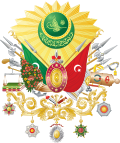This article needs additional citations for verification .(July 2021) |
| State organisation of the Ottoman Empire |
|---|
 |
| Classic period |
| Constitutional period |
This is a list of ministries of the Ottoman Empire . Each ministry was headed by a minister, appointed by the head of cabinet, the Grand Vizier. The Grand Vizier would gradually gain equivalent Prime ministerial powers during the Tanzimat, First Constitutional, and Second Constitutional Eras. [1] He was appointed by the Sultan, who had presidential powers.
- Grand Vizier (Prime Minister)
- Ministry of the Cadastre
- Ministry of Documents
- Ministry of Education
- Ministry of Evkaf
- Ministry of Finance
- Ministry of Foreign Affairs
- Ministry of the Gendarmerie
- Ministry of the Interior
- Ministry of Justice
- Ministry of the Marine
- Ministry of the Private Treasury
- Ministry of Post and Telegraph
- Ministry of Public Works
- Ministry of Trade and Agriculture
- Ministry of War